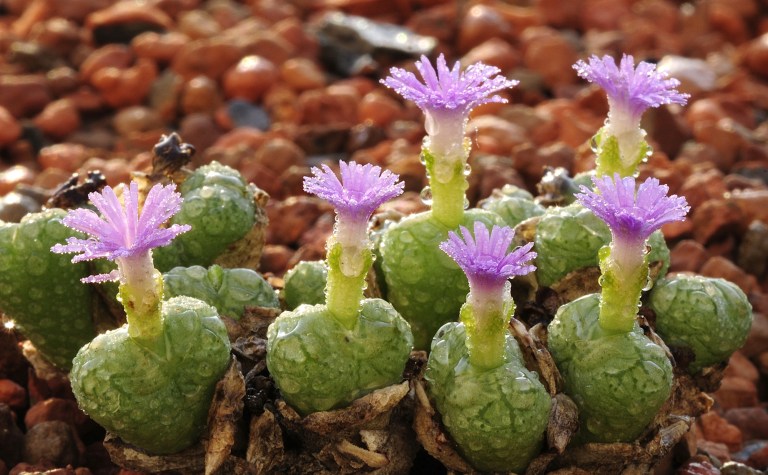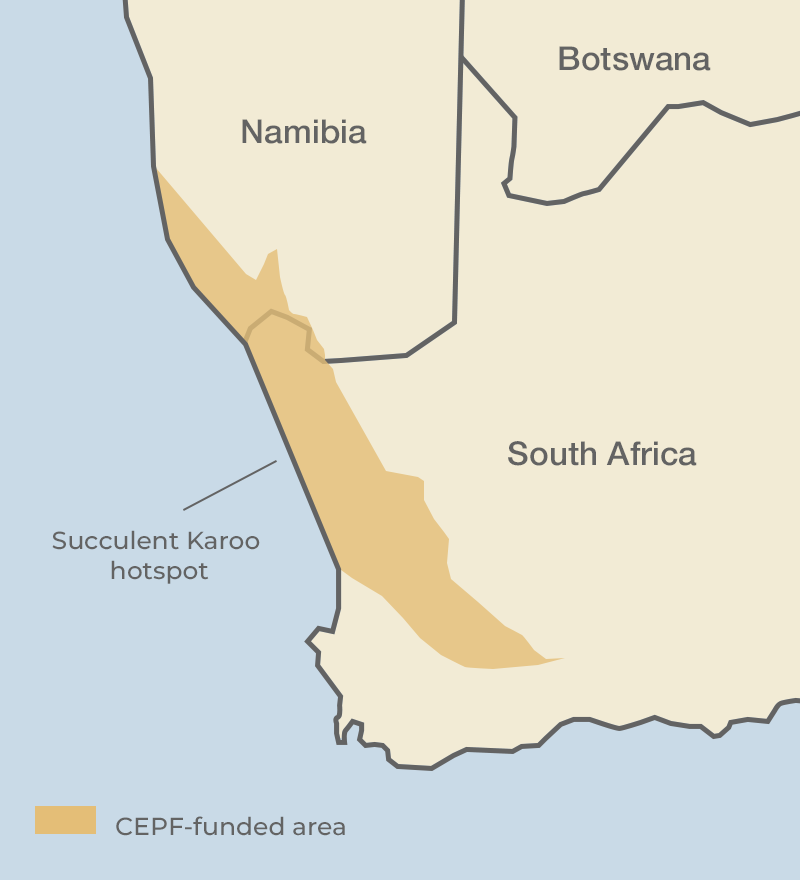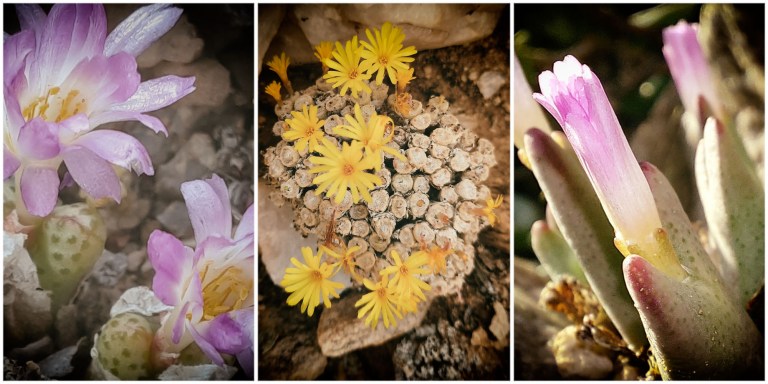
Some of South Africa’s globally unique floral treasures are being decimated by poachers hired by illegal traders. (Photos: SANBI)
By Tony Carnie | 23 May 2023
Overwhelmed by the sheer number of bleeding soldiers at the Battle of Metz in 1793, a French military surgeon was forced to develop a rapid classification system to determine which of the wounded troops needed treatment most urgently.
____________________________________________________________________________________________________________________
More than 200 years later, the triage system developed by Baron Dominique Larrey during the Napoleonic wars is being used locally to stem the casualty list of some of South Africa’s most threatened succulent plant species.
“We have been getting between three and seven plant confiscation cases coming in every week, mostly from the Northern Cape – and the number of plants in each case can vary between 1,000 and 10,000 plants,” says Dr Carina Becker du Toit, a senior botanical scientist at the sharp end of rescue operations for confiscated succulent plants in the Western Cape and Northern Cape.
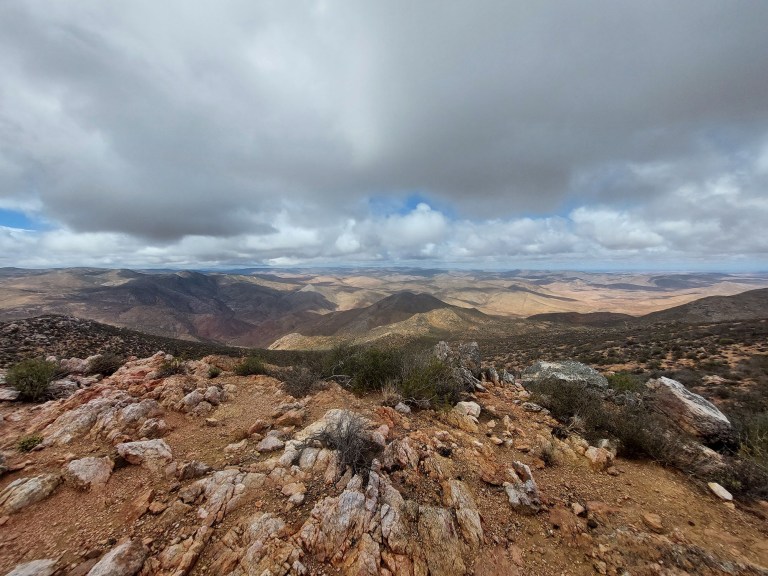
Succulent plant poachers often operate at night in the remote and arid environments of the Northern Cape. (Photo: Sanbi)
In the modern medical context, the colour-coded triage system is still used by paramedics and emergency room workers to filter patients for priority surgical and hospital treatment in the wake of serious accidents and disasters.
In the new conservation context, the botanical casualties are graded mainly by the rarity of each species on the Red List of the International Union for the Conservation of Nature (IUCN)
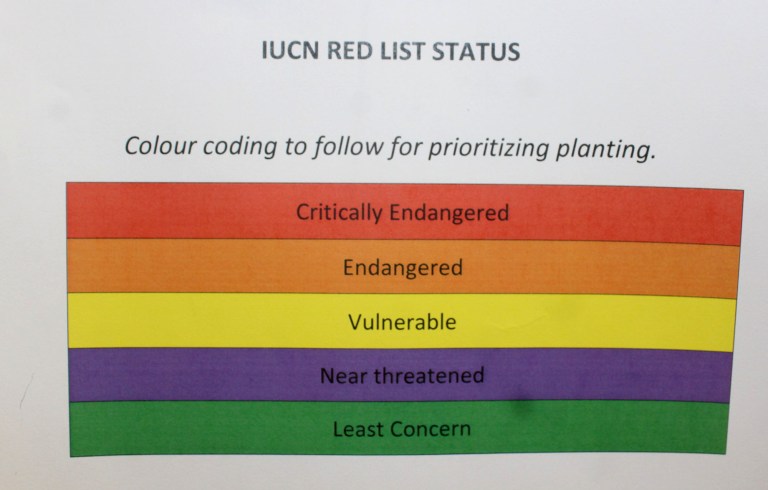
The colour-coded Red List used for succulent plant triage. (Image: Supplied)
While Becker du Toit would like to save as many plant patients as possible after they have been ripped from the veld, there is just not enough space or capacity in the few botanical “hospitals” in these two provinces to sustain their life.
This comes at a time when tens of thousands of poached succulent plants have been confiscated since the Covid lockdown of 2020.
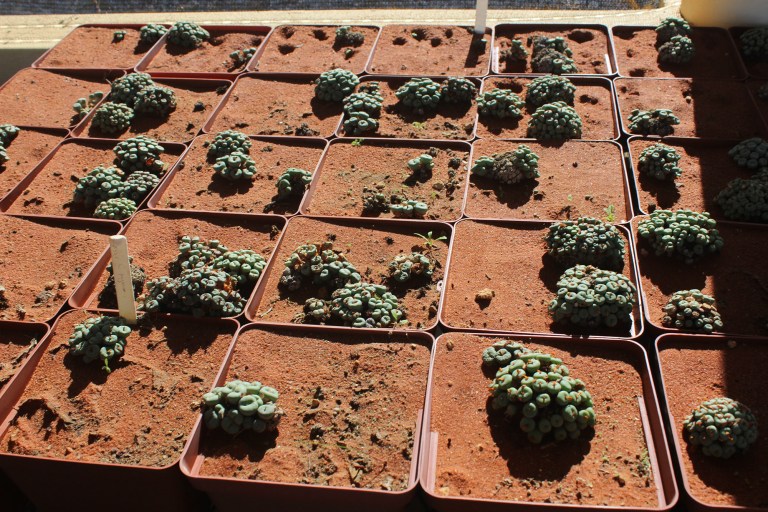
Some of the tens of thousands of succulent plants rescued from plant poachers. (Photo: Tony Carnie)

Just one ‘before’ and ‘after’ example of a site stripped of its globally unique plant life in the Northern Cape. (Image: Sanbi)
“Though some of the plants are quite tough, most have been stored in plastic bags or other containers for some time,” she says, “So when they arrive at our facilities they are in urgent need of soil, trays and watering.”
That means Becker du Toit and her colleagues in the SA National Biodiversity Institute (Sanbi) face a grim choice of which plants to save, due to the limited available resources.
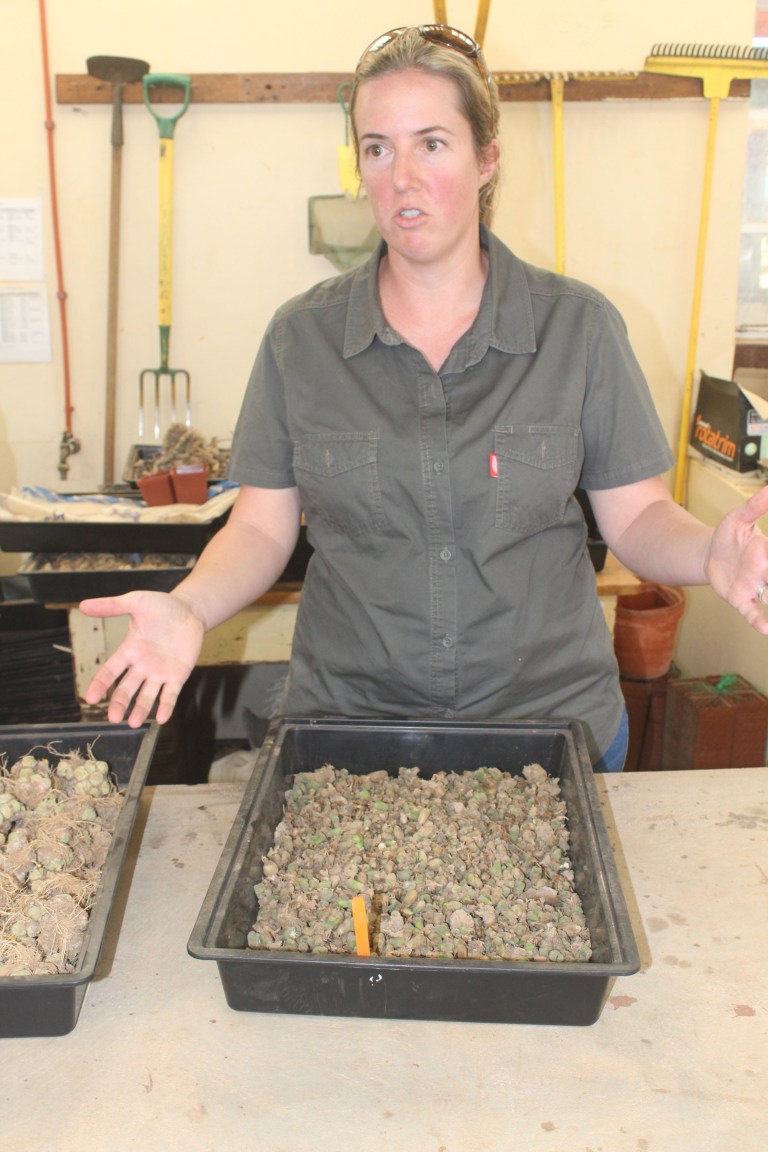
Carina Becker du Toit outlines some of the tough choices that have to be made when choosing which plants receive priority treatment. (Photo: Tony Carnie)
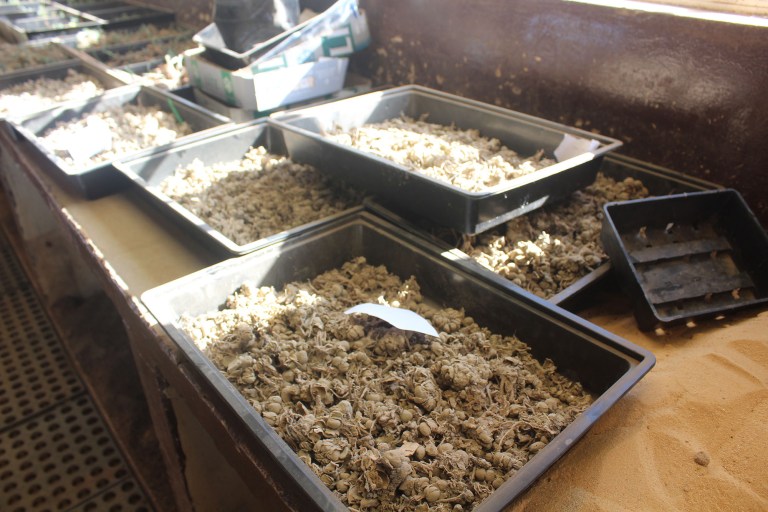
Part of the long line of patients awaiting treatment in one of the emergency rooms operated by the SA National Biodiversity Institute. (Photo: Tony Carnie)
“We focus on the ones that are closest to extinction on the IUCN Red List and those known to exist only in a single location.”
It is these species that will be marked with a red or orange marker for priority care, while those with green markers (least concern category) have to take their chances – should space and staff become available.
Until recently, many of the confiscated plants had been stored in hot conditions, piled up in trays and largely unclassified by their rarity in the waiting rooms. Becker du Toit often had to sort through them laboriously and draw up priority care protocols. To complicate things, the severity of the recent poaching onslaught on some species means that their conservation status is now dynamic.
“The Red List for Conophytums had to be updated in 2020/21 because of the poaching surge – and all Conophytums species are now threatened,” says Sanbi project manager Ismail Ebrahim.
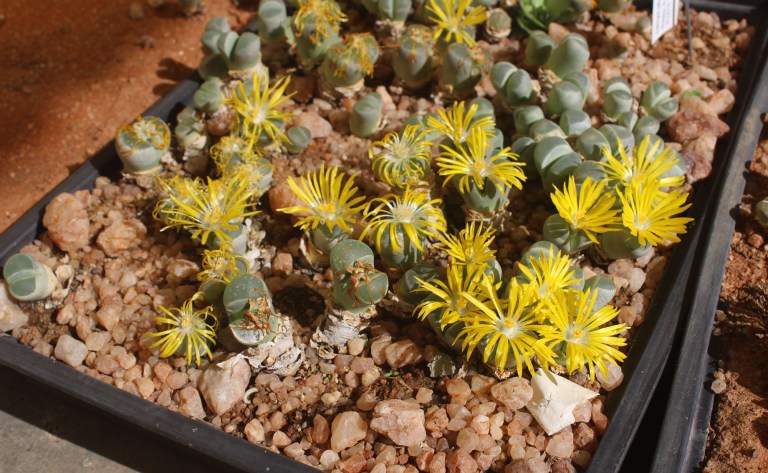
These Conophytum plants rescued from plant poachers may have another shot at life. (Photo: Tony Carnie)
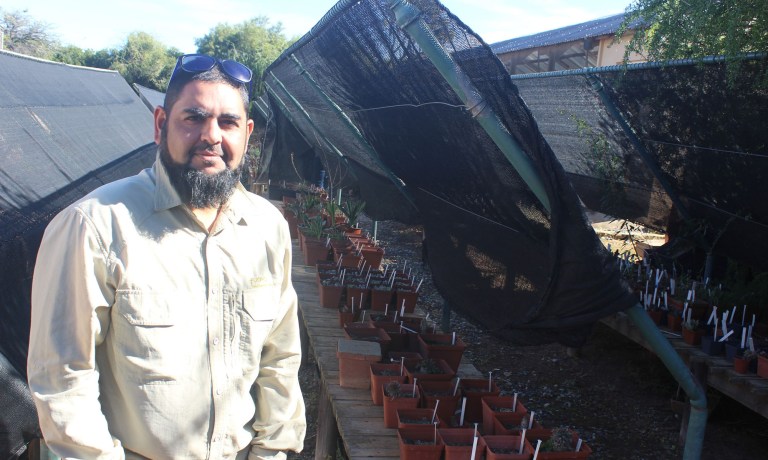
SANBI project manager Ismail Ebrahim surveys a long line of plants in a makeshift recovery ward. Some will be returned to their original native habitat, if located. (Photo: Tony Carnie)
While some members of this plant family were previously listed under “least concern”, most now fall in the “endangered” or “critically endangered” categories.
Small populations, limited ranges
One of the reasons for this, Ebrahim explains, is that some local succulents have very small populations or limited geographic ranges. In some cases, they are found in just one place.
“The entire global population of an endemic plant can be wiped out from their wild habitat in a single day by illegal plant collectors,” says Ebrahim, suggesting that it is vital to raise awareness about the plant poaching crisis and to instil a greater sense of public custodianship.
As things stand, the death or demise of rare plant families seldom arouses the same sense of public outrage or sentiment as the slaughter of iconic animals like rhinos, or the abuse of domestic pet species.
Plants live and breathe and many are beautiful. But there is not quite the same sense of connection as with our animal brethren. All the same, potted plants are increasingly prized as both ornaments or relatively low-maintenance “pets” by city folk across the world, in an era where large swathes of humanity have been cut off from the natural world and confined to more sterile urban environments
Global demand
If they were multiplied commercially in nurseries this would not be such a big deal, but the increasing global demand for smaller, brighter or unusual plant species is reaching the point where extinction is now a real possibility for many species due to illegal and indiscriminate plant collection.
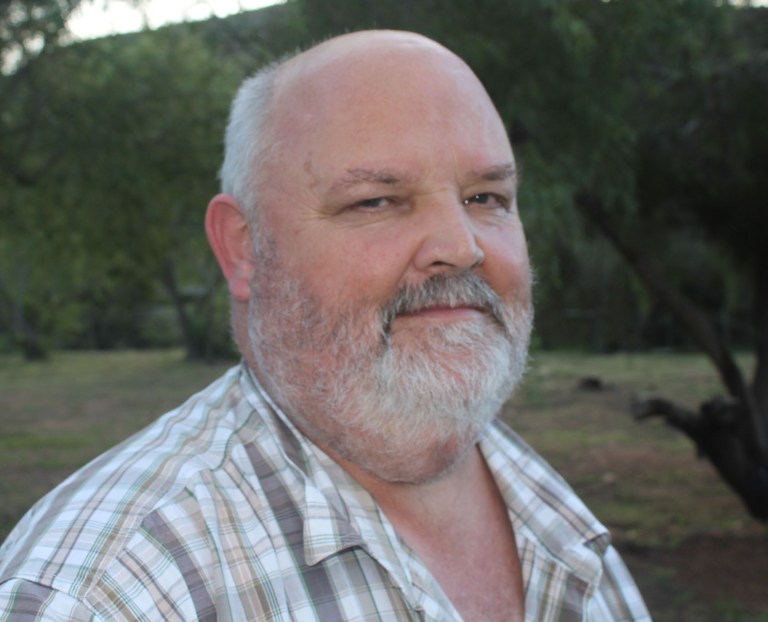
CapeNature environmental crime investigator Paul Gildenhuys. (Photo: Tony Carnie)
Paul Gildenhuys, a founding member of CapeNature’s environmental crime unit, has little doubt that South Africa’s rare succulent plants fall squarely in the crosshairs of this burgeoning global demand – and is increasingly driven by illegal trade syndicates that also deal in rhino horns, elephant tusks, abalone, armaments or drugs.
“Rare succulents are now just another commodity for crime networks that trade in low-risk, high-reward fauna and flora products,” he says.
Gildenhuys and his colleague Carl Brown find it difficult to pinpoint the exact reasons why succulent plant smuggling has “exploded” over the past three or four years, but say the evidence points strongly towards growing demand by collectors in China and some of its neighbours.
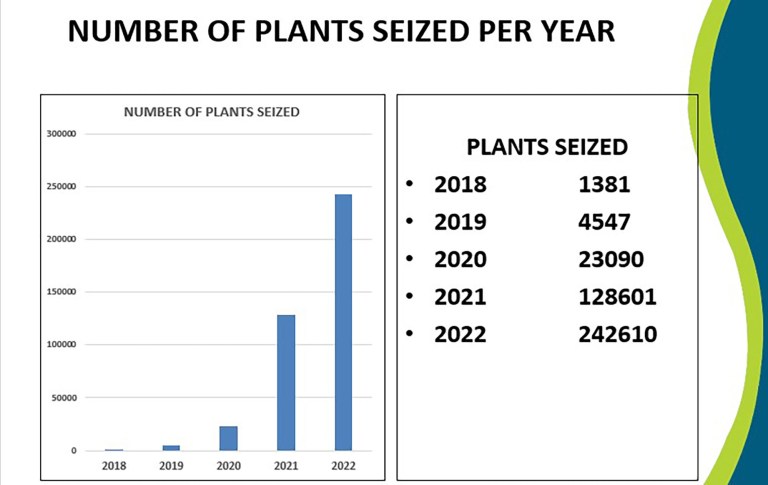
A graph of recent succulent plant seizures, in the Western Cape alone, shows an almost vertical trendline in illegal poaching. (Graph: Paul Gildenhuys CapeNature)
Gildenhuys says local scientific and botanical literature has been translated into Mandarin recently, while social media and new succulent plant craft markets have also played a big role in stimulating consumer demand.
Back in 2001, when Gildenhuys dealt with his first plant poaching case, the culprits were mostly specialist collectors, often from Europe or the United States. The trade has since moved sharply eastwards – most strikingly after the Covid lockdown.
Whereas most foreign plant collectors used to visit South Africa in person to scout out locations or collect plants, there has been a distinct switch to hiring South African collectors – often poor or unemployed rural residents – who strip sites indiscriminately to collect as many plants as possible.
‘Covid changeover’
“We call this the ‘Covid changeover’,” says Brown. “Before lockdown, we were mostly seeing Czechs, Slovenians and other European collectors.
“There is a danger with ethnic profiling, but the reality is that most of the stuff is now going to China. The Chinese economy is growing and there is a great interest in plants in many cities. Most people live in a flat in a high-rise building and there is a desire to have succulents to decorate their apartments.”
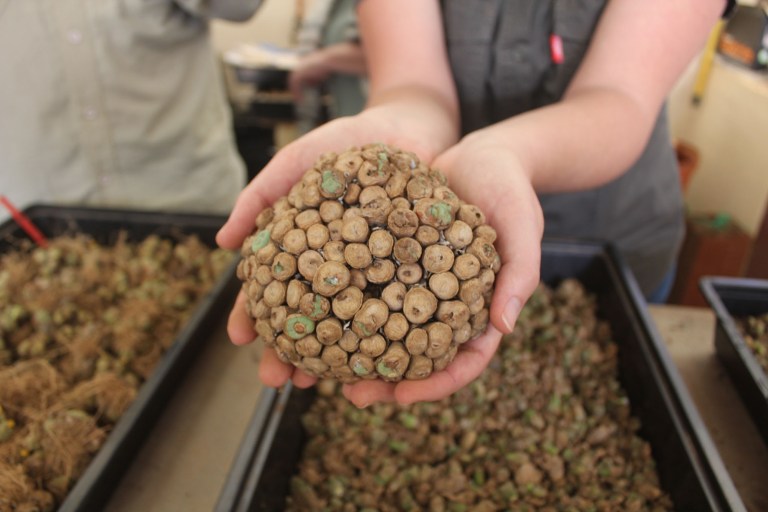
Some of South Africa’s succulent treasures grow for up to 150 years and it is these plants that are often targeted. (Photo: Tony Carnie)
Unfortunately, wealthier collectors are also on the lookout for “character” plants – sculpted into unusual shapes by over a hundred years of exposure to tough, arid environments – rather than the more common species and shapes available from mass-production nurseries in China.
The concern around this growing illegal trade to China has also manifested itself in the recent launch of the “Clean Internet for Conophytum” campaign by the China Biodiversity Conservation and Green Development Foundation.
According to the foundation, campaign leaders recently wrote letters to three leading Chinese e-commerce platforms (Xianyu, Tencent and Taobao) urging them to remove all illegal wild Conophytum products from their websites. They also suggested that buyers be discouraged from illegal transactions via a new “ecological civilisation” awareness campaign.
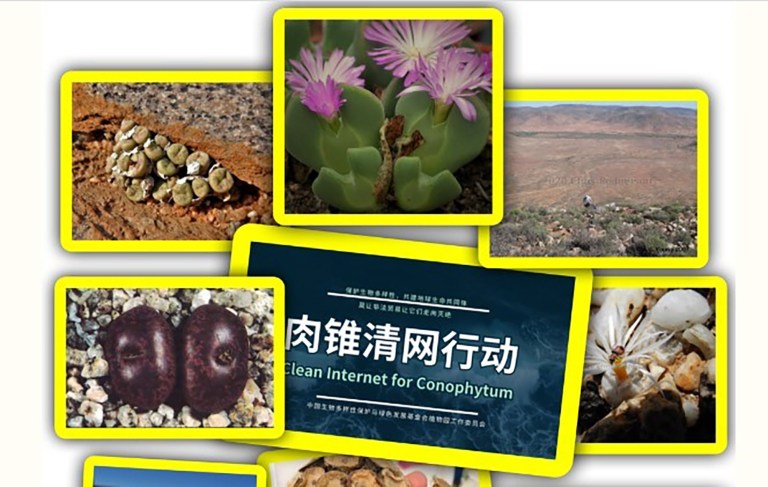
China launched a ‘Clean Internet for Conophytums’ campaign in March 2023. (Image: Supplied)
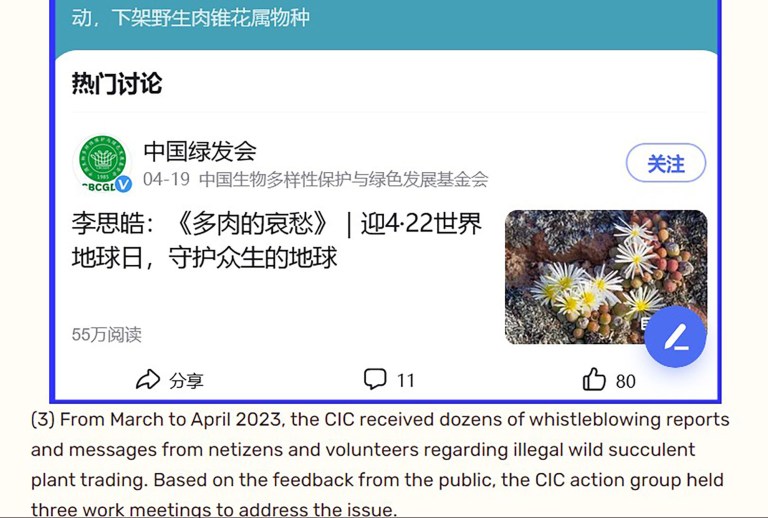
Screenshot from a Chinese ‘Clean Internet’ campaign to reduce the smuggling of rare succulent plants from South Africa. (Image: Supplied)
But the campaign appears to have had very little impact so far on what Becker du Toit describes as a “tsunami-wave” of poaching over the past three years.
At a recent media briefing, CapeNature officials outlined some of the methods used by smugglers to transport plants from remote locations via the postal/courier system, or by road to Cape Town or Gauteng.
Some examples include hiding plants inside pockets of onions, in sealed toy boxes destined for China via FedEx, or concealed in decorative pillows, boxes of biscuits or dried fruit.
Based on recent confiscation data, Sanbi estimates that more than 1.5 million South African succulent plants have been removed from the wild over the past three years alone. DM







